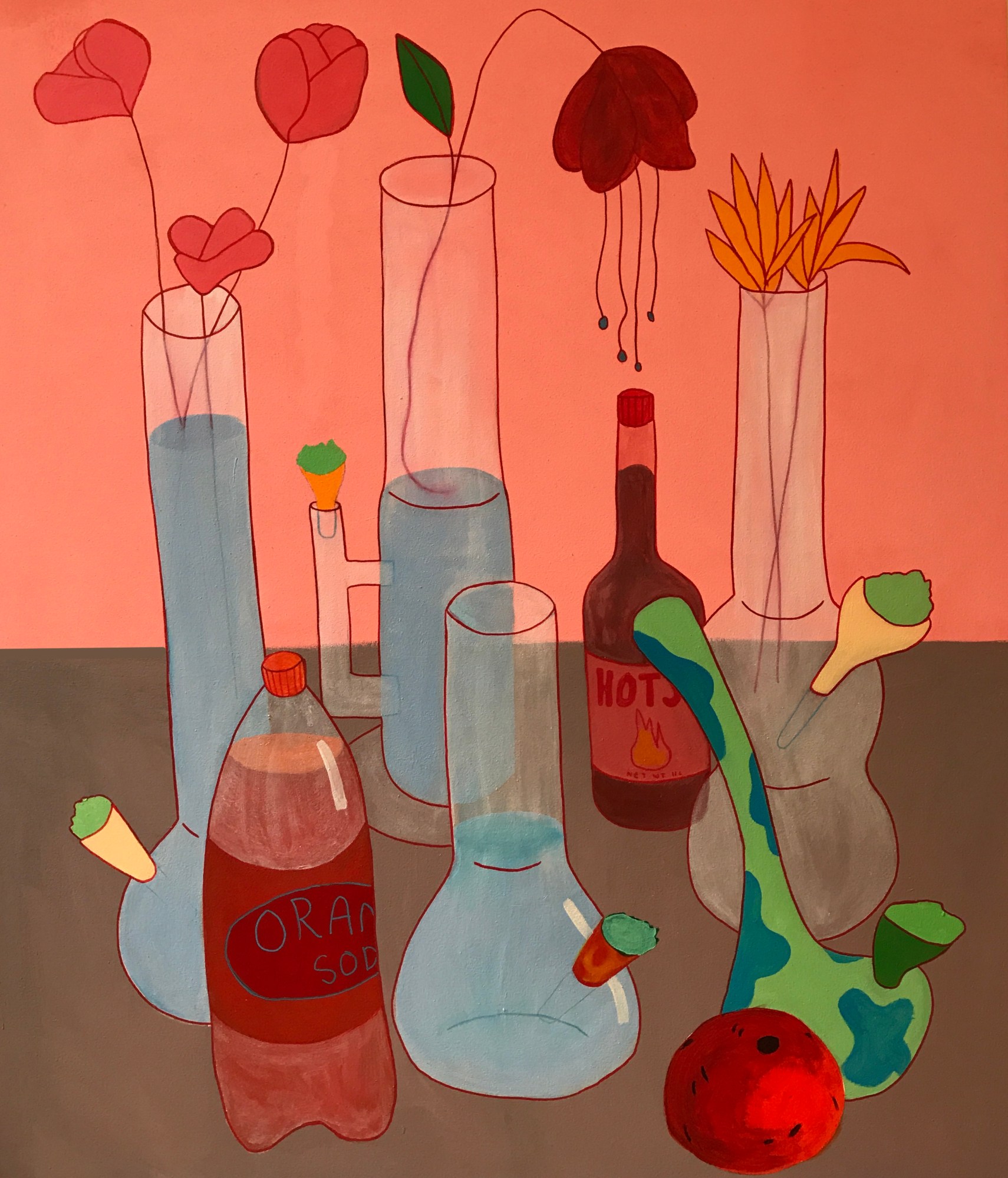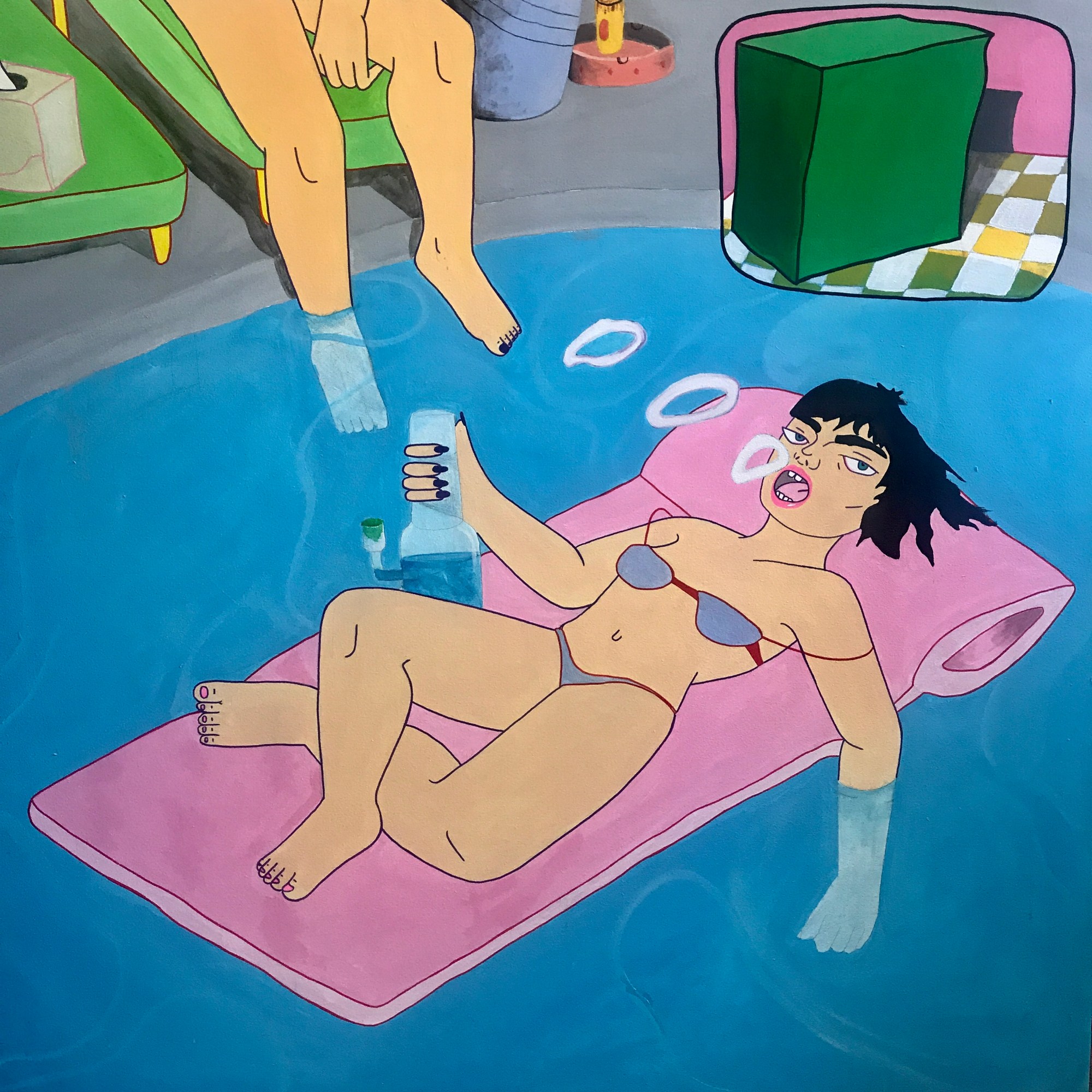In one of New York-based artist Ben Evans’s paintings at KINK — his exhibition presented by The TAX Collection at Guy Hepner in New York — a figure in a black bondage mask and Calvin Klein underwear sits on the floor with a breakfast tray. On the tray are a triple cheeseburger, soda, and three long-stemmed poppies in a water-filled bong. It’s a surreal scene, which, as the gallery describes, is the artist’s way to “expose and normalize what people do behind closed doors.” But for Ben the work in this exhibition is much more personal than that: “It’s an assemblage of self-portraits done at a pivotal point in my coming of age,” he says, “and full-bodied recognition of my ‘queerness.’” In 2013, Ben moved from his native North Carolina to New York, where he felt encouraged to question his role as a gay man in America and his gender. Because of that, none of the figures in his work are gendered (they also tend to be masked, with nipples that are cleverly obscured). “In a lot of ways, the work is totally personal,” Ben explains in the following interview with i-D. “In other ways, it’s totally not. I am exploring myself but also want to be a part of the end of gender norms and a two-gender system.”

What is your new exhibition about?
The show, in a lot of ways, is a corny punchline pointed at me by me. The solitude in the works is weird, funny, and oftentimes seen as “relatable everyday activities,” but for me, the show is so deeply personal and a true testament to how being alone can make someone fetishize themselves in a way that isn’t objectifying or imposing, but dynamic and self-loving.

Why are interior spaces and solitude reoccurring themes in your work? Do you think it’s tied to being homeschooled as kid?
Totally. I was homeschooled for one year when I was 13. It was a transitional year from middle to high school and truly the most impactful 12 months of my life. I was in the swings of puberty, and I don’t think I spent time with anyone my age for the entire year — a decision I made myself. Isolation can do really crazy things to developing minds.
A lot of my life I spent trying to force myself into large social settings that I never actually wanted to be a part of. I told myself it was wrong to not want to be outgoing and that something was wrong with me for not having this desire. As overly clichéd as it sounds, I think every good artist draws what they know. I know interiors. I know being inside most of the day. I exist so much in solitude, especially when I was creating this particular body of work, that it would feel totally phony to be making art about anything else.

Why do you often depict your figures in fetish gear?
When I think about the idea of kinkiness, the first thing I think of is latex masks. These symbols are so immediate in their read and have so much baggage tied to them already that I wanted to play with the idea of individuals wearing this stuff on their own, and it almost becoming a uniform of truth in their private spaces.

Why is it important to your work that your figures aren’t gendered? Is it so that everyone can relate to it?
I think gender exploration is something that I’ve always been inspired by and proud of. This current generation is actively shifting gender norms and not pigeonholing any psychical exterior with any definitive gender. Not all women have vaginas. Not all men have penises. The world I am creating is a safe space in a lot of ways. None of the characters are meant to be gendered and I think the fact that they are “relatable,” which is a secondary result, is really amazing.

Why is it important to you personally? How do non-gendered figures allow you to have a “queer exploration” of yourself?
As a queer, gay man who comes from North Carolina and currently lives in New York, I have really seen a disparity of culture and exploration even within the LGBTQ+ community from one place to another. I think now living in a place where difference is celebrated allows for me to inspect and question my own gender and the way I have previously internalized my limitations as a gay male in American culture. These figures, as I said previously, represent no gender, and for me the exclusion of nipples and genitalia within the works totally de-sexualizes the forms and allows for them to become an extension of myself and how I explore my queerness.
What do you hope people think about when viewing your work?
I hope people can have a cathartic experience looking at it because that’s what I felt making it.
“KINK” is on view at Guy Hepner gallery in New York through March 16 2018.
